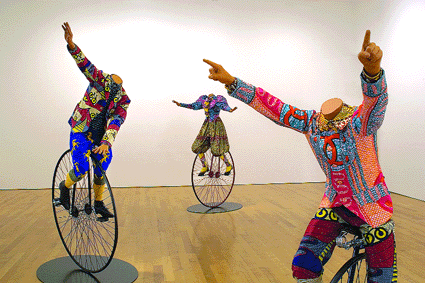Critics’ focus on race, class in Yinka Shonibare’s work misplaced, even insincere
Upon entering the Yinka Shonibare show at James Cohan Gallery, I couldn’t help but think of the “Dangerous Liaisons” costume collection show at the Met two summers ago. The gallery exhibition is made up of saucy vignettes of period tailoring now redone in “African cloth.”
The installation “Reverend on Ice” features a figure based on a famous 18th century English painting of an ice skating minister by Raeburn; it is all silent glide done over in clashing pattern. In the main gallery a family of Victorian unicyclists barrels forward on the edge of becoming Seurat’s circus clowns. In a very post-something gesture, Shonibare uses Dutch wax-printed fabric, his trademark material—think Richard Serra’s monumental steel plates or Dan Flavin’s florescent lights––as the means to recast the past. While this faux batik also gives Shonibare’s work a recognizable identity within international art circles, it does tend to overshadow other elements of the costume pieces. The gesturing hands of the mannequins, in particular, are beautifully cast and assume the expressive role normally played by the face. There is a terrific sense of the body and theater in the placement and dynamic physical presence of the figures.
In the back gallery are the “Toy Paintings,” which Shonibare actually does himself as opposed to the installations, which are done by assistants at his direction. They are toys in a very real sense and paintings in name only, which begs the question, “Are the costume installations just big dress-up dolls?” Thick edged stretchers faced in Africa cloth and painted in cake icing swirls—reversing in three pieces—that almost become patterns, each having five little toys skewered like butterfly specimens on one side of the edge. I found them daunting, even after a second look, so I asked the question.
Doing so clarified my feeling that the “paintings” are slightly overblown studio practice, work that artists do to limber up, similar to Chris Olifi’s recent show of pretty ladies at the Studio Museum. I was put off by the fact that the work is presented in an installation format but is being sold individually. This presents an awkward situation for the “Toy Paintings,” which aren’t very much on their own, but the issue becomes acute in the case of the unicyclists, which you experience as a family. They lose energy and interest hand over fist when viewed as distinct objects.
Perhaps Shonibare is a case of critics gassing on at the slightest provocation or it may be the situation that the artist has soft pedaled his politics a bit here, but for all of the critical focus on race and class it is hard to read those issues when confronted with the actual work presented in this show. What is apparent are details such as the Chanel double C logo hidden in one of the batik patterns or the unmistakable mark of tableaux vivant charade that each attests to a chain-yanking Goyaesque humor and a willingness to amuse.
Art rag critics have disingenuously traded heavily on Shonibare’s African birth in making a case for him as an outsider. Speaking Yoruba at home while living an upper class lifestyle in London that included maids, surgeon brothers, and attendance at crusty art schools including Byam Shaw and Goldsmiths hardly makes one a naïf. I’m just not buying the talking dog sideshow, even if it is very well dressed. These installations are as detailed, sharp and as over the top as anything by Matthew Barney.
gaycitynews.com


































